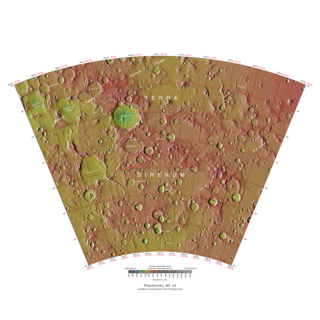
Galle is a crater on Mars. It is located on the eastern rim of the huge impact basin Argyre Planitia in Argyre quadrangle. It is named after the German astronomer Johann Gottfried Galle. Galle is often known as the "happy face crater" because pareidolia causes a curved mountain range in the southern part of the crater and two smaller mountain clusters further north to appear to be a smiley face. The formation was first photographed by Viking Orbiter 1.

Proctor is a large crater in the Noachis quadrangle of Mars, located at 48° south latitude and 330.5° west longitude. It measures 168.2 kilometres in diameter and was named after Richard A. Proctor, a British astronomer (1837–1888).
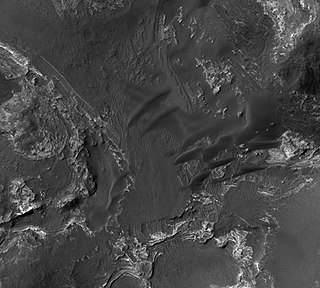
Orson Welles is an impact crater in the Coprates quadrangle of Mars, located at 0.2° S and 45.9° W. It is 124.5 kilometers in diameter and was named after Orson Welles (1915–1985), an American radio and motion picture actor and director. He is famous for, among other things, his radio broadcast of The War of the Worlds by H. G. Wells in which Martians invade Earth. The layers and the clay minerals found in Orson Welles Crater are evidence that it once contained a lake.

Schaeberle is a crater in the Iapygia quadrangle of Mars, located at 24.7° S and 309.9° W. It measures approximately 159 kilometers in diameter and was named after John Martin Schaeberle, an American astronomer (1853–1924).

Baltisk is a crater in the Argyre quadrangle of Mars. It is located at 42.7° South and 54.7° West, is 52 km in diameter, and was named after a town in Russia. Baltisk is located on the western edge of the Argyre impact basin.

Maunder is an old, eroded crater on Mars, located in the Noachis quadrangle at 50 South and 358.5 West. It measures 91 kilometers in diameter and was named after British astronomer Walter Maunder in 1973.
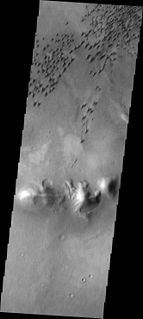
Arkhangelsky Crater is a crater in the Argyre quadrangle of Mars, located at 41.4° S and 24.8° W. It is 117 km across and was named after the Russian geologist A.D. Arkhangelsky.
Green Crater is an impact crater in the Argyre quadrangle of Mars, located at 52.7° S and 8.4° W. It is 184.0 km in diameter and was named after Nathan E. Green, a British astronomer (1823-1899).

Danielson Crater is an impact crater in the Oxia Palus quadrangle on Mars at 7.93° N and 7.11° W. and is 66.7 km in diameter, and is north of the Meridiani Planum, south of Arabia Terra and west of the planet's meridia. Its name was approved in 2009, and it was named after American engineer G. Edward Danielson.

Wright is an impact crater in the Phaethontis quadrangle of Mars, located at 58.9°S latitude and 151.0°W longitude. It measures approximately 114 kilometers in diameter and was named after American astronomer William Hammond Wright (1871–1959). The naming was approved by the IAU in 1973. The Keeler–Trumpler crater pair lies to the south.

Keeler is an impact crater on Mars, located at 61.0°S latitude and 151.3°W longitude in the Phaethontis quadrangle. It is 95.0 km in diameter and was named after James Edward Keeler, and the name was approved in 1973. The first image below shows the relationship among three craters that are near each other. Keeler Crater is to the North of Trumpler Crater. After Keeler was formed, a later impact formed Trumpler Crater, and in the process destroyed part of Keeler.

Liu Hsin Crater is a crater in the Phaethontis quadrangle of Mars, located at 53.6°S latitude and 171.6°W longitude. It is 137.0 km in diameter and was named after Liu Xin. Liu Hsin was a Chinese astronomer, historian, and editor during the Western Han Dynasty and the Xin Dynasty. The name was approved in 1973 by the International Astronomical Union (IAU) Working Group for Planetary System Nomenclature (WGPSN).
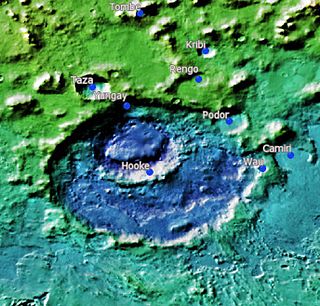
Hooke Crater is an impact crater in the Argyre quadrangle on Mars at 45.2°S and 44.4°W and is 139.0 km in diameter. It was named after British physicist-astronomer Robert Hooke.

Clark Crater is a crater in the Phaethontis quadrangle of Mars, located at 55.6°S latitude and 133.4°W longitude. It is 98.0 km in diameter. It was named after American astronomer Alvan Clark; the name was approved in 1973.
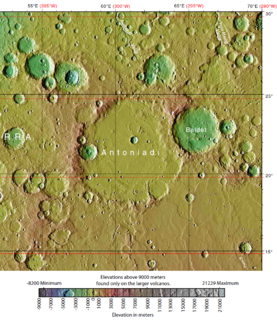
Baldet Crater is an impact crater in the Syrtis Major quadrangle of Mars, located at 23.0°N latitude and 294.6°W longitude. It is 180.0 km in diameter and was named after Fernand Baldet, and the name was approved in 1973 by the International Astronomical Union (IAU) Working Group for Planetary System Nomenclature (WGPSN).

South is an impact crater in the Mare Australe quadrangle of Mars, located at 76.9°S latitude and 21.9°E longitude. It measures 101.84 kilometers in diameter and was named after British astronomer Sir James South (1785–1867). The name was approved in 1973, by the International Astronomical Union (IAU) Working Group for Planetary System Nomenclature.
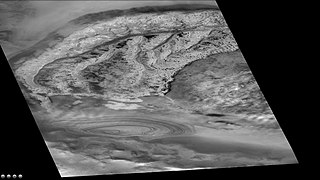
Jeans is an impact crater in the Mare Australe quadrangle of Mars, located at 69.8°S latitude and 205.9°W longitude. It is 80.2 km in diameter and was named after James Hopwood Jeans, and the name was approved in 1973 by the International Astronomical Union (IAU) Working Group for Planetary System Nomenclature (WGPSN). The pictures below show dark areas in which frost is disappearing and the dark ground beneath is being exposed. Layers are also visible—probably from the many cycles of mantle deposition.

Schmidt is an impact crater on Mars, located in the Mare Australe quadrangle at 72.3°S latitude and 78.1°W longitude. It measures approximately 201 kilometers in diameter. It was named after German astronomer J. F. Julius Schmidt and Russian geophysicist Otto Schmidt. The naming was officially approved by the International Astronomical Union (IAU) Working Group for Planetary System Nomenclature in 1973.

Playfair is an impact crater in the Mare Australe quadrangle of Mars, located at 78.1°S latitude and 126.2°W longitude. It measures 64.2 kilometers in diameter and was named after Scottish scientist and mathematician John Playfair. The naming was approved in 1973, by the IAU's Working Group for Planetary System Nomenclature.
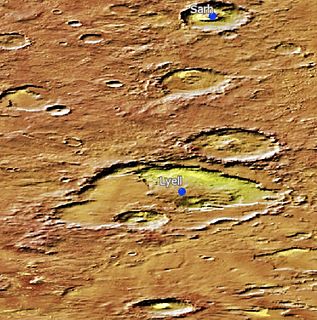
Lyell Crater is an impact crater in the Mare Australe quadrangle of Mars, located at 70.1°S latitude and 15.6°W longitude. It is 121.0 km in diameter. Its name refers to British geologist Charles Lyell.

